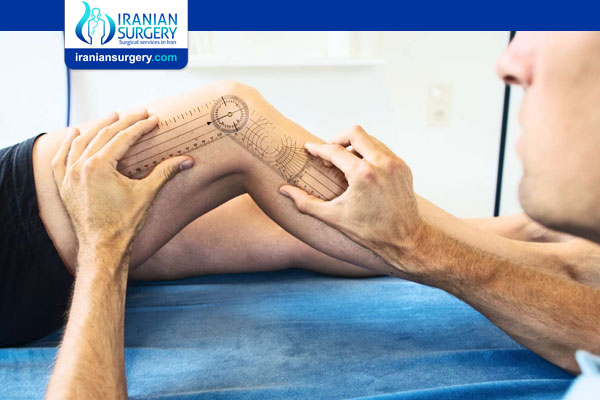Arthrofibrosis
What is Arthrofibrosis?
Arthrofibrosis is a condition in which you have a buildup of scar tissue around a joint, usually after a traumatic injury or surgical procedure. It’s especially common in the knee. Arthrofibrosis can be debilitating, limiting your range of motion and causing substantial pain.
Conservative treatments like rest, pain medication, and exercises are usually tried first. If they don’t help, surgery may be needed to remove the excess scar tissue.
Before Arthrofibrosis Treatment
Arthrofibrosis Symptoms
The primary symptoms of arthrofibrosis include:
. Pain, which can be severe and constant
. Stiffness in the joint
You may also develop:
. An inability to straighten your leg, resulting in a limp
. An inability to bend your leg
. Swelling or warmth in the joint
. A grating sound or sensation when you move the joint (called crepitus)
Symptoms can become more debilitating than the original injury or the problem that prompted surgery, making it difficult to walk, drive, or get in and out of a chair.
Causes
Arthrofibrosis is a common complication of procedures such as anterior cruciate ligament (ACL) reconstruction surgery and total knee arthroplasty (TKA). The condition is caused by inflammation and the creation of excess of scar tissue.
Your body’s natural response to trauma, such as from an injury or surgery, is to make scar tissue. Some people tend to make too much, especially if they have an infection at the site or another problem that complicates healing.
According to a 2019 study, that may be due to a disruption in the healing process. Essentially, your body doesn’t get the message to stop the healing process even after the trauma is repaired, so it just keeps making scar tissue.
Scar tissue is dense and fibrous. When it forms in abundance, it can bind down the joint and prevent the normal range of motion. The process also can cause your muscles and connective tissues to shorten and harden (called contractures.)
How serious is arthrofibrosis?
Arthrofibrosis can be very serious and cause pain plus significant limitations on your mobility and activity levels. Early diagnosis and treatment can keep it from getting to that point.
Diagnosis
When you go to the healthcare provider with symptoms of arthrofibrosis, they will generally give you a physical examination and ask about your history of injury or surgery. They’ll also look at your ability to flex your knee.
To confirm the diagnosis and get a feel for the extent of the problem, you’ll likely be sent for magnetic resonance imaging (MRI) and X-ray.
According to current diagnostic criteria, arthrofibrosis can be diagnosed when the limited range of motion in the joint is persistent despite conservative treatments.
However, some researchers question whether this is a valid criterion because some confirmed cases have involved minimal range-of-motion loss but have still been considerably painful and disabling.
Prevention
Preventing arthrofibrosis after surgery is best accomplished with early range of motion rehabilitation. Arthrofibrosis used to be much more common after ACL surgery when healthcare providers used to restrict patients’ mobility to allow the ligament to heal.
Now, due to advances in surgical techniques and rehabilitation, most surgeons are instructing their patients to move the joint within hours or days of surgery, and that’s lowered the likelihood of arthrofibrosis.
A 2019 study cautions against “aggressive” physical therapy, though, because exercise can trigger inflammation and, in some cases, worsen the problem.
During Arthrofibrosis Treatment
Treatment
The first treatment for arthrofibrosis is rest, ice, and anti-inflammatory medications to reduce the pain and swelling. You’ll likely be advised to start gentle range-of-motion exercises to increase flexibility. You may also be referred to physical therapy to improve your use of the joint.
If that doesn’t solve the problem, then you have the option of two common procedures: manipulation under anesthesia or surgical removal of scar tissue. Both are performed in the operating room under anesthesia, and they can be performed in combination in some cases.
In the non-surgical option, you’re put under general anesthesia and the healthcare provider forcefully bends your leg to break up scar tissue.
The surgical option, in which the healthcare provider goes in and removes the scar tissue, is more common. It’s typically performed arthroscopically (with small incisions). Following surgery, it is important to have physical therapy to regain strength and motion as well as to prevent further formation of scar tissue.
Can arthrofibrosis be cured?
No, arthrofibrosis can’t be cured right now. Most cases resolve with conservative treatment, though, and newer, better treatments are in the works.
After Arthrofibrosis Treatment
How long does it take to recover from arthrofibrosis?
Recovery time depends on the severity of your arthrofibrosis. With a mild case and proper treatment, your symptoms may go away in a few weeks.
For more advanced cases, which may require surgery, it can take much longer. Your healthcare provider can give you an estimate based on multiple factors.
Source:
. https://www.verywellhealth.com/arthrofibrosis-2548476

